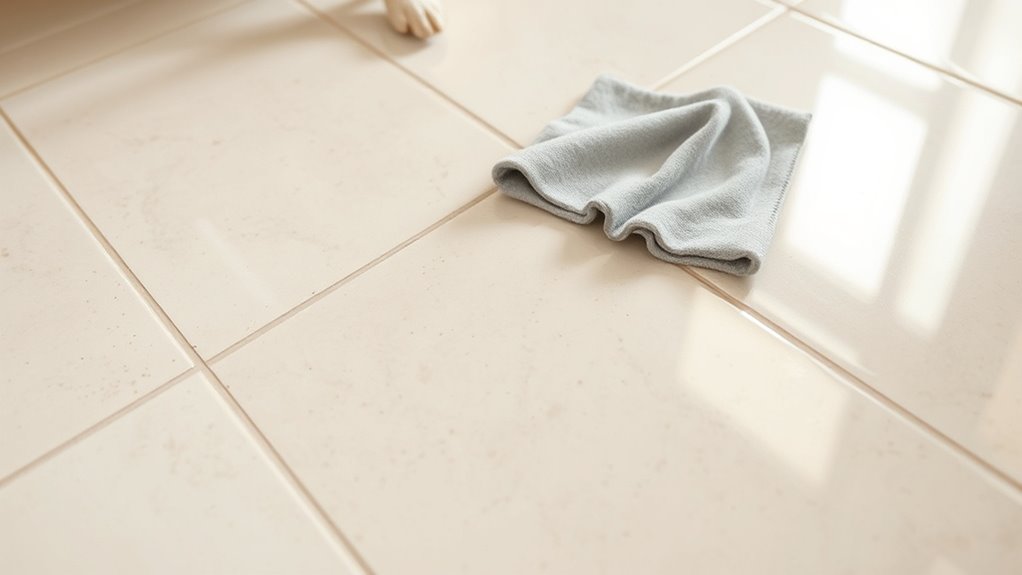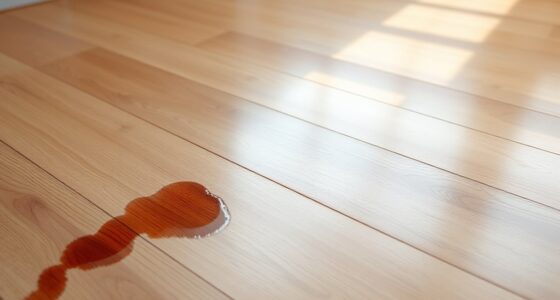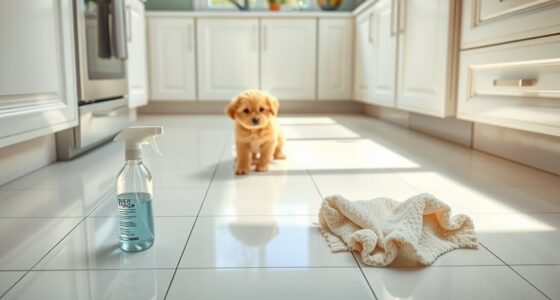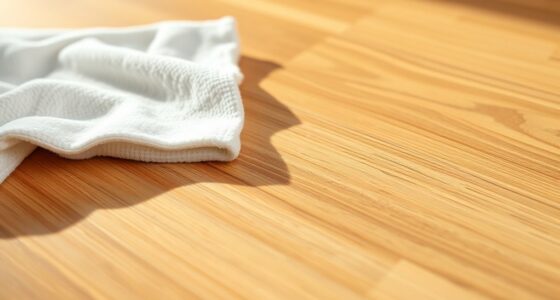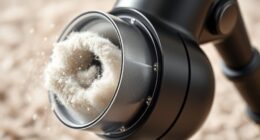To safely and odor-free clean pet messes on grout lines, start by blotting fresh stains with paper towels. Use enzymatic cleaners designed for pet odors, and apply them with small brushes or spray nozzles to reach deep into tight grout gaps. Rinse thoroughly, then let the area dry completely. After cleaning, sealing the grout can help prevent stains and odors. Keep exploring for more tips on keeping your space fresh and spotless.
Key Takeaways
- Use enzymatic cleaners specifically designed for pet stains to safely eliminate odors from grout lines.
- Employ small brushes or narrow grout scrubbing tools to gently clean deep into tight grout crevices.
- Rinse thoroughly with clean water after cleaning to prevent residue buildup and mold growth.
- Apply grout sealant after cleaning to create a barrier that repels moisture and stains.
- Sprinkle baking soda on grout lines post-cleaning, let sit overnight, then vacuum to absorb lingering odors safely.
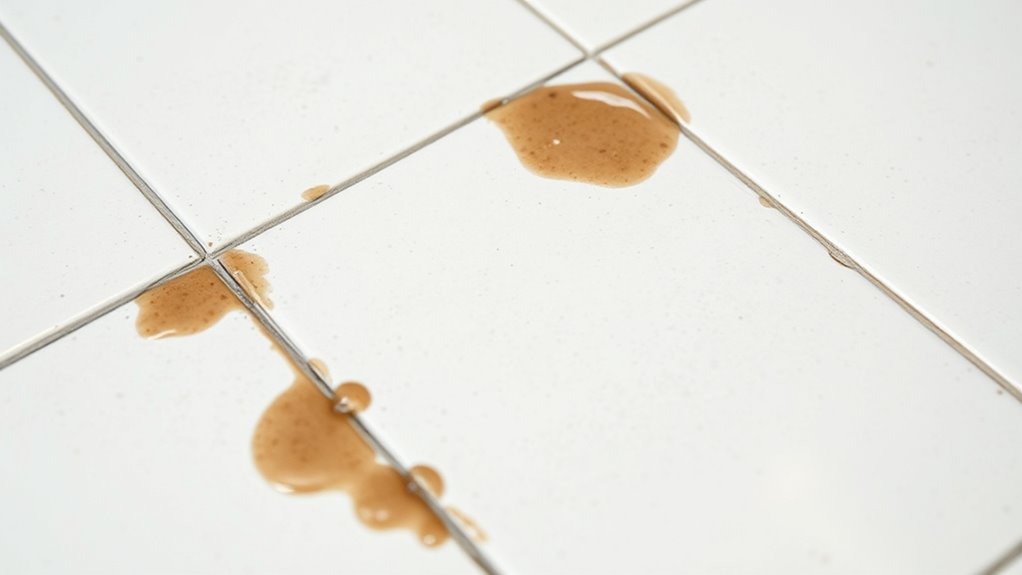
Pet messes on grout lines can be a frustrating challenge to clean, especially since these narrow gaps tend to trap dirt, stains, and odors. The tight spaces make it hard to reach with regular cleaning tools, leaving behind residues that can worsen over time. To effectively tackle this issue, you need the right cleaning tools designed to fit into these small crevices. Small brushes, such as toothbrushes or grout scrubbing brushes with narrow heads, are ideal for breaking up dirt and loosening stains in grout lines. Also, using a handheld steam cleaner can be a game-changer, as the high heat and pressure help lift grime without the need for harsh chemicals. When cleaning pet messes, it’s important to focus not only on removing visible dirt but also on eliminating lingering odors. Odor elimination should be a priority because pet stains often leave behind smell particles that attract pets back to the same spot.
To ensure thorough odor removal, start by blotting up any fresh mess with paper towels or a clean cloth. Avoid rubbing, which can push stains deeper into the grout or spread the mess further. Once the surface is as dry as possible, apply an enzymatic cleaner specifically formulated for pet stains. These cleaners break down organic compounds responsible for odors, ensuring a safer and more effective cleanup. Use a small brush or a spray nozzle to work the cleaner into the grout lines, making sure it penetrates deeply into the narrow gaps. Let it sit for the recommended time to allow the enzymes to do their job, then scrub gently with your chosen cleaning tools to lift out any remaining residues. Incorporating HEPA filtration into your cleaning routine can further improve air quality by removing airborne allergens and odors associated with pet messes.
After scrubbing, rinse the area thoroughly with clean water to remove any leftover cleaning solution and loosened dirt. Dry the grout lines with a clean towel or allow them to air dry to prevent mold or mildew growth. For ongoing odor control, consider applying a grout sealant that repels moisture and stains, making future cleanups easier. You might also sprinkle baking soda along the grout lines after cleaning, letting it sit overnight before sweeping or vacuuming it away; this natural odor absorber can help keep your space smelling fresh. Regular maintenance with appropriate cleaning tools and odor-eliminating products keeps your grout lines clean, fresh, and free of pet mess residues. Doing so not only improves the look of your tiled surfaces but also creates a healthier environment for you and your pets.
Frequently Asked Questions
Can I Use Bleach to Clean Pet Messes on Grout Lines?
You can use bleach to clean pet messes on grout lines, but it’s not always the safest choice. Bleach safety concerns arise from fumes and potential damage to grout. Instead, try natural alternatives like vinegar or baking soda, which are effective and odor-free. These options minimize health risks for your pets and family while thoroughly cleaning stains and odors. Always dilute and test any cleaner first to avoid damage.
How Often Should I Deep Clean Grout Lines Affected by Pets?
You should deep clean your grout lines affected by pets every 1 to 3 months, depending on the frequency of maintenance and stain prevention efforts. Regular cleaning prevents pet stains from setting and keeps odors at bay. Use safe, odor-free cleaners to preserve a fresh, clean surface. Consistent deep cleaning ensures your grout stays spotless, improves its longevity, and makes future stain prevention easier.
Are Natural Remedies Effective for Pet Stain Removal on Grout?
Pet stains on grout can be tricky, but natural remedies often work surprisingly well. While DIY solutions like baking soda and vinegar can lift odors without harsh chemicals, commercial products are designed for stubborn stains and deep cleaning. You might find a blend of both effective, depending on the mess. Natural remedies offer a safe, odor-free option, but for tough, persistent stains, don’t hesitate to try specialized commercial cleaners.
What Signs Indicate Grout Damage From Pet Accidents?
You’ll notice signs of grout damage from pet accidents, like grout discoloration, or dark, stained areas that won’t go away. Cracked grout lines are also common, indicating deterioration over time. If you see these issues, it’s a sign you need to clean and repair the grout promptly. Addressing these signs early helps prevent further damage and keeps your flooring safe, clean, and looking fresh.
Is It Safe to Use Steam Cleaners on Pet-Affected Grout Lines?
Yes, it’s safe to use steam cleaners on pet-affected grout lines for pet stain removal, as long as you use them correctly. Steam helps lift stains and odors without harsh chemicals. After cleaning, consider grout sealing to protect against future pet accidents. Just make certain the grout is thoroughly dry before sealing, and avoid excessive steam to prevent damage. This method keeps your grout clean, odor-free, and protected.
Conclusion
Now that you know how to tackle pet messes on grout lines safely and odor-free, imagine what surprises might still be hiding in those tricky corners. Will your next cleanup be as easy as this one? Stay prepared and keep your home fresh—because the next unexpected pet mess could be just around the corner. Are you ready to handle it with confidence? The secret to a spotless home is in your hands.
